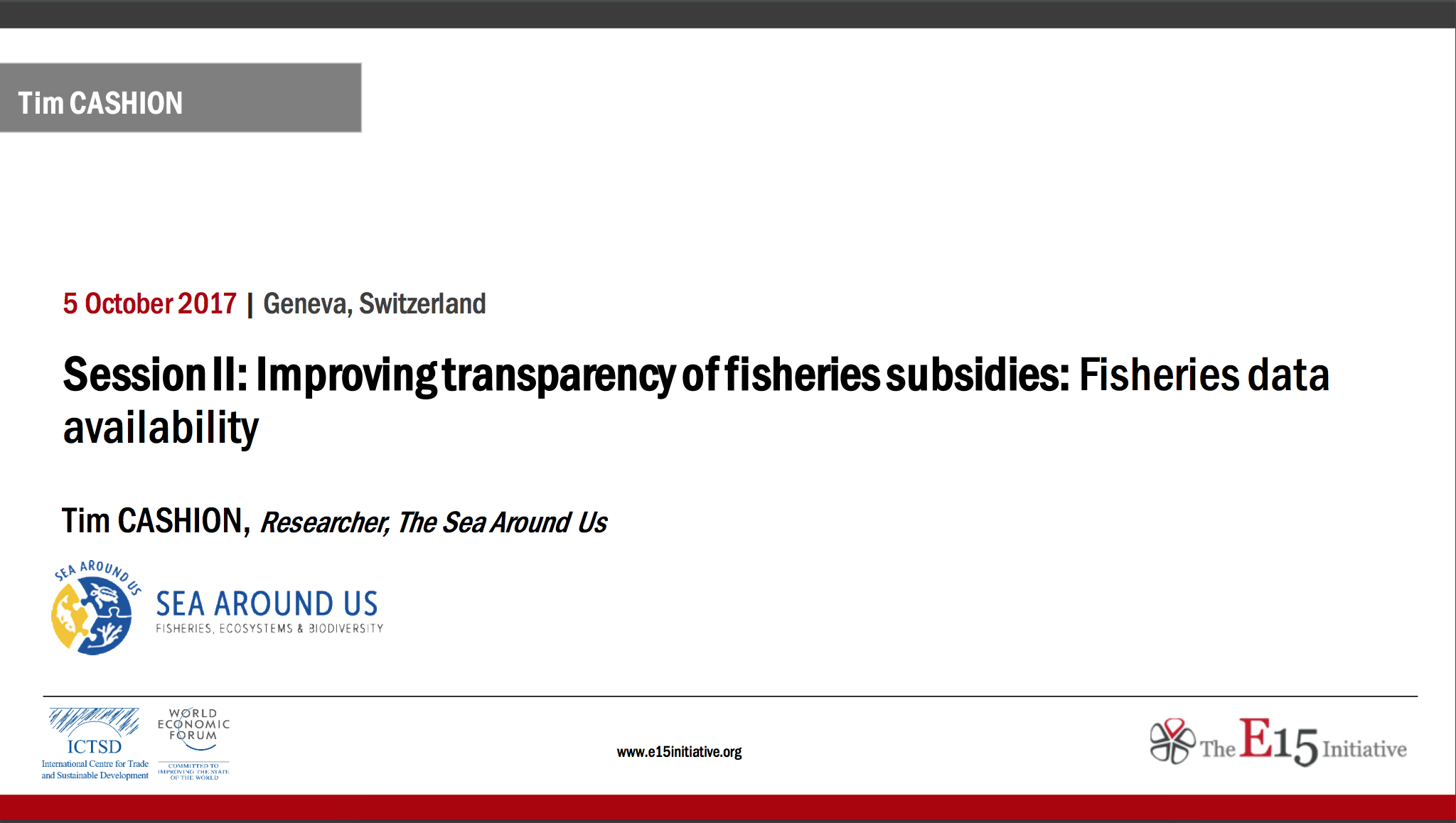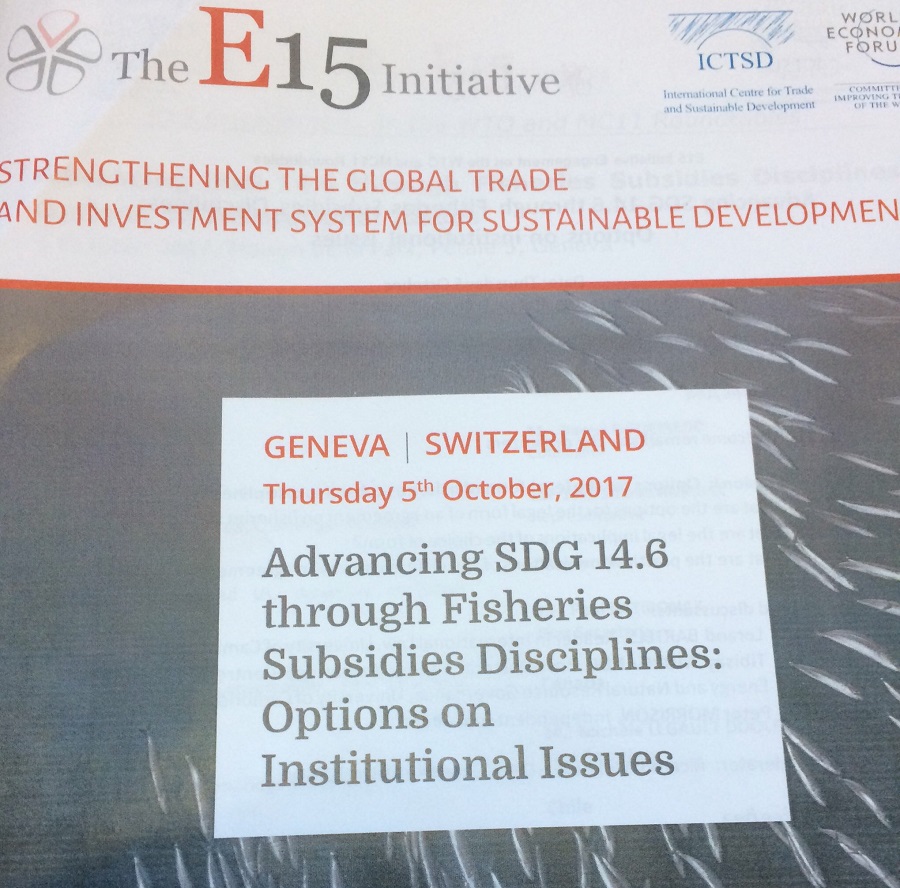Text and photos by Tim Cashion.
In early October, I had the opportunity to travel to Geneva to present on behalf of Sea Around Us and the Fisheries Economics Research Unit for a roundtable discussion on fisheries subsidies. The discussion was convened by the E15 Initiative and the International Centre for Trade and Sustainable Development. The ICTSD has been working closely with Rashid Sumaila of the Fisheries Economics Research Unit for several years on the topic of fisheries subsidies. They have used his research in partnership with Sea Around Us to inform countries of the amounts of fisheries subsidies and designated them as the good (beneficial), the bad (harmful), and the ugly (ambiguous).
Fisheries subsidies are broadly implicated with overcapacity of fisheries and allowing fisheries to continue to operate past the point where they are no longer profitable. This is important as the loss of revenue from depleted fish stocks should act as a feedback mechanism to reduce fishing pressure or effort, but subsidies distort the level at which this would occur. The elimination of harmful fisheries subsidies is even a target within the UN’s Sustainable Development Goals. It would have large effect on the 14th goal to ‘Conserve and sustainably use the oceans, seas and marine resources for sustainable development’, also known as the ‘life below water’ goal.
The roundtable was focused around two sessions of presentations. The first presentations of the morning focused on the form of the agreement within the existing WTO framework. The presenters focused on the most desired options of a new annex to the SCM agreement which would be legally binding to all WTO members. This would have the greatest effect and would bring all WTO members under these same rules to eliminate harmful fisheries subsidies to overfished stocks.
The second session of presentations focused on the transparency elements of the proposals. Most of these relate to countries reporting on their subsidy programmes and the fisheries that are receiving them. A barrier to this is countries that believe this will put an undue pressure to find and report new data. However, existing FAO and Sea Around Us data can provide two different sources for much of the information required including catches by species, status of the fishery (i.e., overfished, fully fished, developing), and fleet capacity of the fishery.
I began my presentation focusing on the areas of the proposal where Sea Around Us data could fill existing gaps. Mainly, we provide data on catch by specie of the fisheries, stock status for different jurisdictions, and we will soon have more detailed information on catches by gear, and an independent reconstruction of fishing effort. All of these data will be important to help identify different fisheries components where they are currently more aggregated (as for most countries’ fisheries), and to identify what fisheries are having a harmful effect on their fish stocks. I highlighted the different dimensions of fisheries data available on the Sea Around Us website, and some delegates were surprised to see this information available for their fisheries in this way.
The delegates asked questions about the importance of WTO managing fisheries, and how these data would help in achieving the proposed agreement’s goals. I focused on how this information can be used to identify fisheries that should no longer receive subsidies. However, this is a more difficult process to go through rather than to ban certain types of subsidies that may or may not lead to overfishing. For example, subsidies to fuel lower the cost of fishing and allow fishers to continue fishing beyond what would normally be profitable. This can be beneficial while fish stocks are healthy to the fishers and the positive economic impact in the economy, but can become detrimental if it leads to economic overfishing and depleting fish stocks faster than they regenerate. While one could focus on banning particular types of subsidies based on their likely impact, the current proposal is an ‘effect-based’ proposal for eliminating subsidies where we can demonstrate harmful effects.
The importance of this roundtable is to make progress on some of the finer points of the proposal before the WTO’s ministerial meeting in Buenos Aires in December. This meeting in December is the most likely chance for an early agreement on reducing or limiting harmful fisheries subsidies especially to IUU fisheries. There is broad agreement over eliminating subsidies provided to IUU fisheries and fisheries on overfished stocks, and that is the reason the proposed agreement has taken this form. In addition, since this roundtable, a new version of the proposed text has been completed by many of the parties present that harmonizes points where the proposals diverged before. Progress is being made, and with less than 2 months to go, this is the time to work together for this agreement. There is a real opportunity to end many harmful fisheries subsidies in December after years of deliberation. Let’s not miss this chance.




